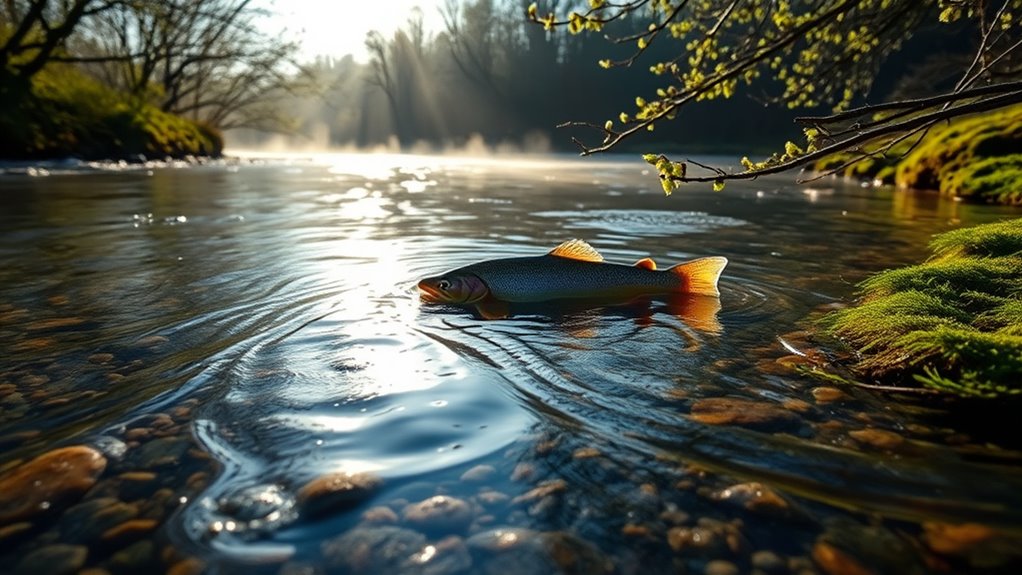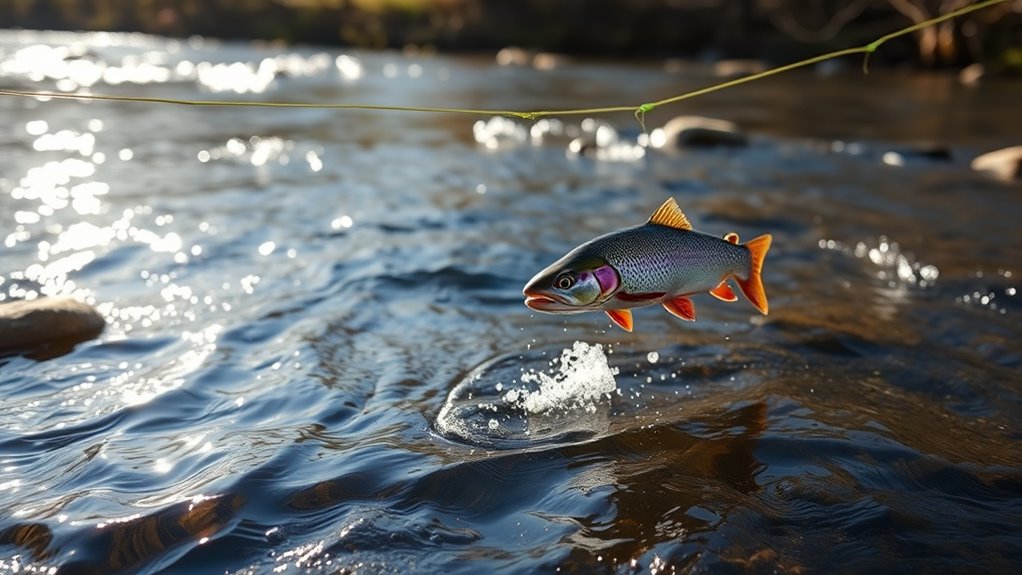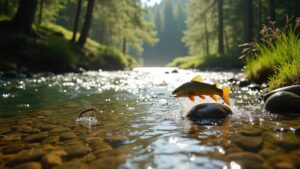In spring you’ll shift from deep-winter holds to seams, confluences and transitional pockets as turnover and wind-driven mixing redistributes oxygen and prey; trout move shallower and feed more when water warms toward about 10–15°C, especially in rising or stained flows that flush sculpins, crayfish and minnows. Use subsurface tactics—sinking lines, weighted nymphs or slow streamers—fish seams and deep holes with slow retrieves and pauses, and you’ll pick up the best fish if you want to learn more.
Important Takeaways
- Spring turnover mixes oxygen and nutrients, moving trout from deep winter holes toward shallower, transitional feeding depths.
- As water warms toward 10–15°C, trout metabolism and insect activity increase, creating pulsed feeding windows.
- Rising, stained spring flows concentrate prey and trout along seams, confluences, and color-change points.
- Use subsurface tactics—sinking lines, weighted nymphs, streamers, and slow strips—to reach holding depths.
- Present casts upstream into seams and deep holes, mend for slow drifts, and trigger follows with short jerks or pauses.
The Science Behind Spring Stillwaters
Why does spring change everything on stillwaters? You notice spring turnover when surface warming and wind cause water column mixing, breaking the stillwater thermocline and redistributing dissolved oxygen and nutrients. As layers homogenize, trout shift from deep winter holes toward transitional and shallower trout feeding depth zones you can target. Your fish respond to rising temperatures—around 10–15°C they boost metabolism and feed more opportunistically. Early spring insects like midges, mayflies, and caddisflies become more active as the water warms, creating pulsed food that attracts trout throughout the mixed column. By understanding turnover-driven movement and oxygen redistribution, you’ll time presentations and adjust depth choices to match where trout concentrate during this dynamic season. Make sure you also verify local regulations and licensing requirements before heading out, since local fishing regulations can affect seasons, limits, and permitted methods.
Reading Rising and Stained Rivers
As spring warms waters and breaks up stratification, rivers respond with surging, stained flows that rearrange food and fish; reading those changes tells you where to focus. When rising water displaces crayfish, sculpins, minnows and fry, larger trout follow those concentrates; stained rivers make contrast points obvious. Watch transitional zones — seams, deep holes near creek mouths, and color-change points — for sudden feeding trout activity. Spawning patterns shift distributions, so target confluences and inlets where displaced prey collects. In stillwater inflows or outlets you’ll find similar concentration effects during rises. Once temps approach 40°F, active retrieves like streamer fishing, crankbaits or spoons in seams and productive transitional zones pay off. Read flow, cast accordingly, and prioritize those hotspots. Always observe and respect local regulations and safety practices when fishing from a kayak, including wearing a PFD and checking weather monitoring before you go.
Early-Season Trout Behavior and Holding Zones

Looking for where trout hide in early spring? You’ll find them in holding zones—deep pools, undercut banks, fallen trees, and boulder-rich pockets act as structure holding area where trout conserve energy and ambush prey.
Early spring trout behavior shifts from surface to subsurface feeding as cooler water reduces top activity, so target seams and transitional zones between winter holes and shallower hatch areas.
Water temperature drives metabolism; when it climbs into the 10–15°C range, trout feed more opportunistically, especially during midday or brief warm spells.
Rising, slightly stained water and spring turnover displace prey, drawing larger fish into confluences, deep holes near creek mouths, and seams—high-probability spots for subsurface presentations.
Match your presentations and lure colors to water clarity and seasonal patterns, focusing on structure and cover to increase hookups.
Gear, Flies, and Lures for Transition Conditions
When water’s on the cool side but trout are starting to feed more actively, switch to subsurface tactics—sinking lines, weighted nymphs and streamers, and a drogue for big-water drifts will keep your flies in the strike zone where fish are holding. In early spring and transitional conditions you’ll favor subsurface nymphs and slow streamer retrieves, targeting deeper holding zones like undercut banks, logs, and rock structure as water warms to 10–15°C. Use weighted rigs, short slow strips, occasional jigs, and swing presentations. Match fly size to local prey, keep leader length conservative, and employ a drogue in windy or large stillwaters to improve contact. Consider wearing a UPF fishing shirt for sun protection and moisture management while you fish; UPF 50+ shirts offer excellent coverage and quick-dry performance.
| Gear | Purpose |
|---|---|
| Sinking lines | Reach depth |
| Weighted nymphs | Hold zone |
| Streamers | Predatory strikes |
| Drogue | Controlled drift |
Drift, Retrieve, and Presentation Strategies

Curious how to keep your fly in the strike zone without spooking sluggish spring trout?
In early spring, favor slow drift and subtle presentation: cast upstream into seams, deep holes and confluences, mend to slow your fly, and keep it near the bottom where trout feed.
Use depth control—sinking lines or weighted flies—especially midday or in stained water when fish move up.
For streamers, employ slow strips with pauses, occasional jigging, and downstream swings to imitate injured prey.
If a fish follows, trigger a bite with a quick jerk or a well-timed pause to convert interest into a take.
Stay patient, minimize splash, and adjust retrieve speed and depth until strikes occur.
Target areas with loose, silt-free gravel where spawning behavior and nearby feeding often concentrate trout.
Final Thoughts
By now you’ve seen how spring’s shifting waters change trout behavior and where they hold. Use that knowledge to read currents and pick your spots, then match your gear, flies, and retrieves to transition conditions. Stay observant, adapt your presentation as visibility and water temp shift, and favor subtle, natural tactics early on. With patience and willingness to tweak technique, you’ll turn the season’s uncertainty into consistent hookups and more rewarding days on the water.

